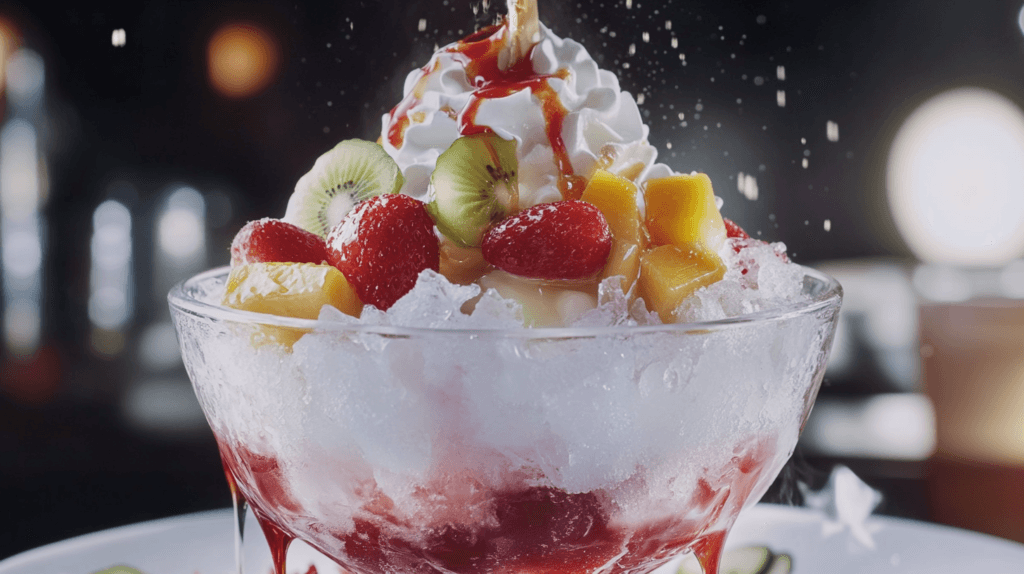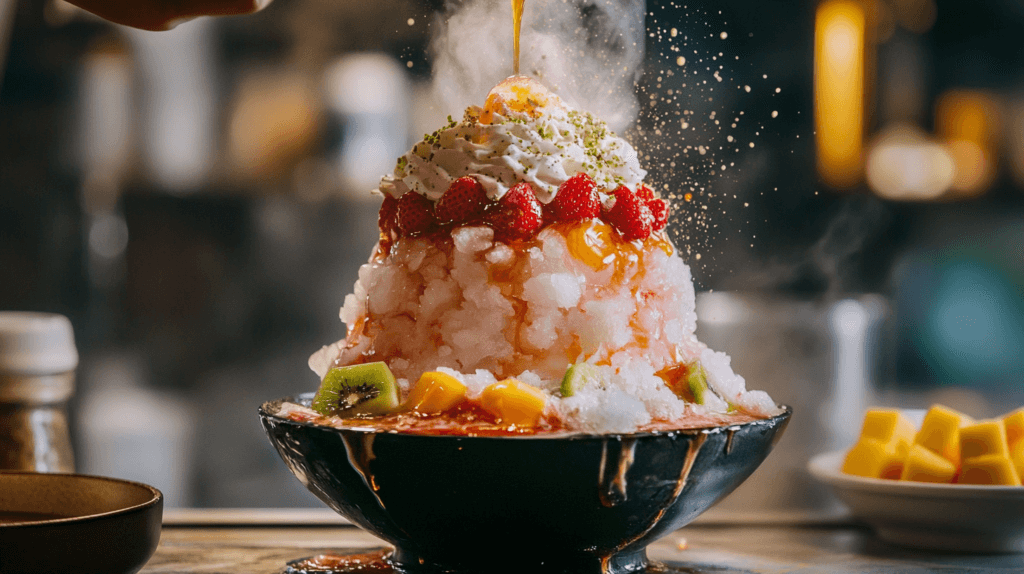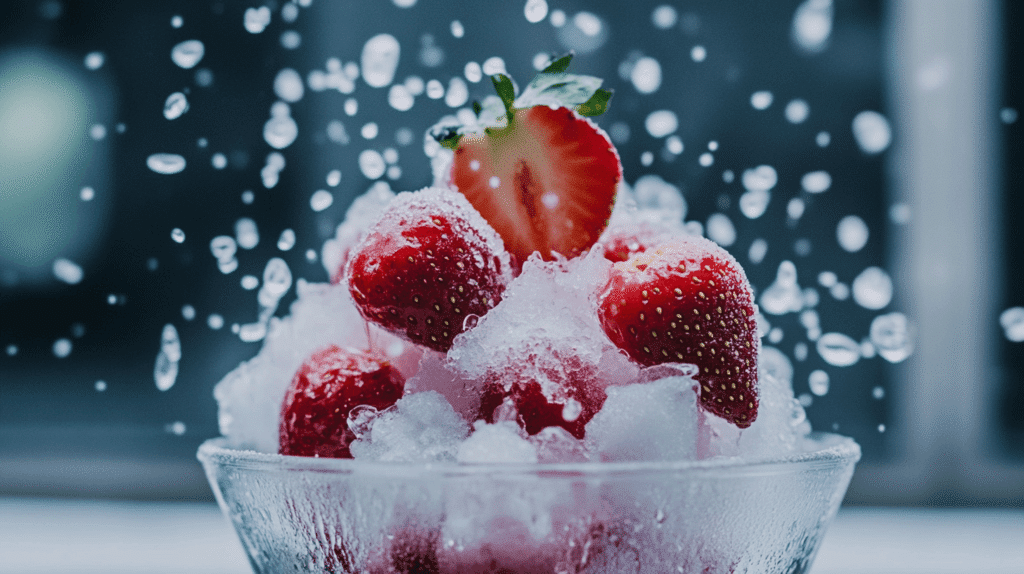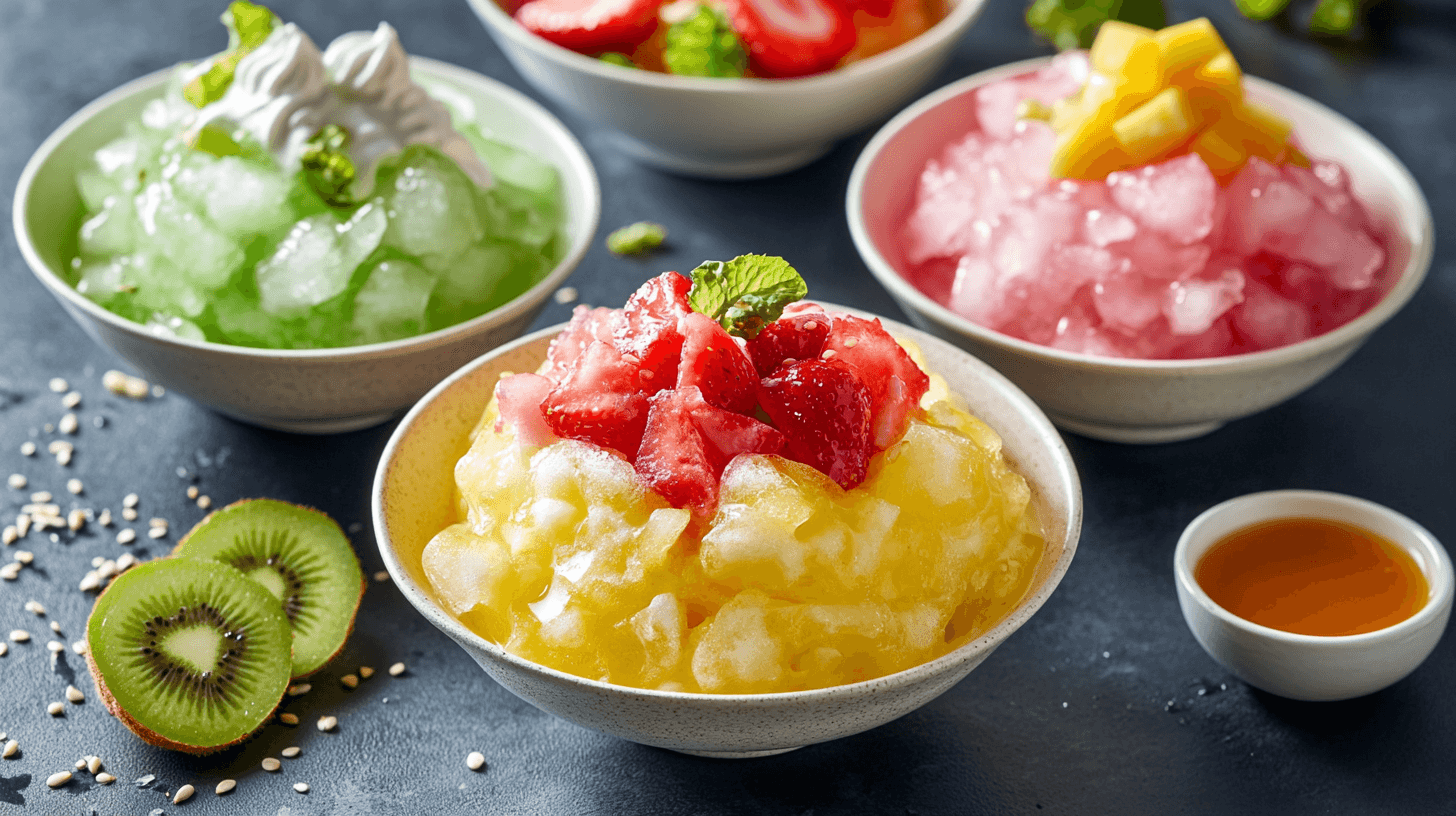When summer hits, kakigori, Japan’s favorite shaved ice, is a cool escape. It’s like a soft snow that melts in your mouth, mixing with sweet syrups and toppings. This treat has won hearts around the world, and it’s easy to see why.
Kakigori is more than a cold snack; it’s a big part of Japanese culture. It started as a fancy treat for nobles in the Heian period. Now, it’s a favorite street food, still loved for its simple yet rich taste.
What is Kakigori Dessert: Understanding Japan’s Famous Shaved Ice
Kakigori, Japan’s famous shaved ice dessert, has a long history. It started in the Heian period (794-1185) and was once only for the rich. Now, it’s a summer favorite for everyone in Japan.
The secret to traditional kakigori is the fine shaved ice. It’s topped with flavored syrups and sometimes condensed milk, fruit, mochi, or red bean paste.
Origins and Cultural Significance
Kakigori’s roots go back to the Heian period. Back then, it was a luxury for the aristocracy. The ice came from mountain streams and lakes, making it rare.
But, with the Meiji era (1868-1912), ice became easier to make. This made kakigori more popular with everyone.
Key Components of Traditional Kakigori
- Finely shaved ice made from pure, natural water
- Sweet, flavored syrups such as strawberry, matcha, or melon
- Optional toppings like condensed milk, fresh fruit, mochi, or red bean paste
Modern Interpretations and Variations
Today, kakigori has many new flavors and looks. In Tokyo, you can find unique kakigori like coffee, watermelon, and lemon ice. These new versions show how versatile this traditional dessert can be.
As the kakigori dessert continues to gain recognition worldwide, its modern variations are inviting a broader audience to appreciate its beauty and intricacies. Whether enjoyed at a street stall topped with classic syrup or in a chic café adorned with gourmet ingredients, kakigori is an embodiment of Japan’s rich culinary heritage, reimagined for contemporary palates. This dessert serves as a testament to how tradition can thrive through innovation, enticing fans of all ages to savor each frosty bite.
The Rich History of Japanese Shaved Ice: From Nobility to Street Food
The origins of kakigori, Japan’s beloved shaved ice dessert, date back over a thousand years. It has grown from a luxury for the elite to a favorite summer treat. This has made it a key part of Japanese culture.
The first kakigori shop opened in 1869 in Yokohama. This was the start of its journey from a rare treat to a common street food. Thanks to better ice transport and new shaving machines in the 19th century, kakigori became more accessible to everyone.
Now, kakigori is a big part of Japanese summer celebrations. It’s a hit at festivals and events all over the country. July 25th is even called Kakigori Day in Japan, showing how much people love it.
The change of kakigori from a royal treat to a street food shows Japan’s changing tastes. Over the years, this dessert has kept up with cultural and social changes. It’s now a symbol of japanese summer food and ice confections.
The Art of Making Perfect Kakigori
Making kakigori, Japan’s favorite shaved ice, is an art. It needs skill and the right tools. From old hand-shaving to new machines, getting that fluffy texture is a mix of tradition and innovation.
Traditional Ice Shaving Techniques
Traditionally, kakigori is made by hand-shaving ice with a kaku-gata. This slow process needs patience and skill. The ice is shaved into fine flakes, then mixed with sweet syrups for a unique taste.
Modern Equipment and Methods
Nowadays, many use kakigori machines for convenience. These machines shave ice fast, making it snow-like. The KitchenAid® Stand Mixer with the Shave Ice Attachment can shave a pint of ice in just a minute, making it easy for everyone.
The Importance of Ice Quality
The ice quality is key for perfect fluffy ice texture. Some places use ice from fresh water sources for better taste. Making kakigori with frozen mineral water takes 12 to 24 hours, showing the care needed for this treat.
Essential Ingredients and Tools for Kakigori Preparation
Making the perfect kakigori, Japan’s favorite shaved ice dessert, needs a few key tools and ingredients. The dessert’s core is the ice, finely shaved like fresh snow. You’ll need a special ice shaver or kakigori machine for this.
Doshisha is a well-known brand that offers both electric and manual hand-crank machines for home use. These make it easy to make this traditional dessert at home. You’ll also need high-quality ice, like clear ice blocks or slow-frozen ice cubes, for a smooth texture.
Kakigori syrup is key for flavor and sweetness. You can buy it or make it yourself. Flavors range from strawberry and melon to matcha green tea and black sesame. Some recipes add creamy condensed milk for extra richness.
Adding toppings like azuki red beans, mochi balls, and fresh fruit can make your homemade kakigori even better. With the right tools and ingredients, you can enjoy a refreshing Japanese shaved ice dessert right in your kitchen.
Classic Kakigori Flavors and Popular Combinations
Kakigori, Japan’s favorite shaved ice dessert, has a wide range of flavors. It goes from traditional fruit syrups to new and exciting mixes. This icy treat has something for everyone, no matter what you’re in the mood for.
Traditional Syrup Varieties
The heart of a classic kakigori is its syrup. Japan’s natural ingredients inspire many flavors. Favorites include matcha green tea, red bean, mango, cherry, strawberry, yuzu, and melon. These flavors are loved by many across Japan.
Contemporary Flavor Innovations
New flavors have made kakigori even more exciting. Now, you can find cookies and cream, avocado, and fig kakigori. These fruity variations and unique mixes offer a fresh take on the classic dessert.
Seasonal Specialties
Kakigori gets even better with seasonal flavors that match the year’s best. Spring brings sakura (cherry blossom) flavors, while autumn offers chestnut ones. These flavors not only taste great but also celebrate Japan’s changing seasons.
Kakigori’s world is full of flavors, from traditional to new. Whether you like the old favorites or the latest creations, this dessert is sure to refresh and enchant you.
The Role of Toppings and Garnishes
Toppings and garnishes are key to making kakigori special. They can turn a simple shaved ice dessert into a feast for the senses. From fresh fruit to mochi ice cream, the right toppings can make all the difference.
Fresh fruits like strawberries, mango, and melon are popular choices. They add natural sweetness and a pop of color. Yuzu, a citrus fruit, also adds a unique flavor.
- Mochi, the chewy Japanese rice cakes, add a fun texture.
- Adzuki bean paste, or anko, brings a creamy, sweet taste.
- Condensed milk drizzled over the ice makes it rich and indulgent.
Some shops like to try new things. They might use oat crumble or black sesame foam. These unique toppings add exciting flavors and textures to kakigori.
| Topping | Description | Flavor Profile |
|---|---|---|
| Fresh Fruit | Strawberries, mango, melon, citrus | Sweet, juicy, refreshing |
| Mochi | Chewy Japanese rice cakes | Soft, chewy, slightly sweet |
| Adzuki Bean Paste (Anko) | Creamy, sweet bean paste | Subtly sweet, creamy |
| Condensed Milk | Thick, sweetened milk | Rich, indulgent, creamy |
| Oat Crumble | Crunchy oat-based topping | Nutty, crunchy, lightly sweet |
| Black Sesame Foam | Airy, light sesame-flavored foam | Nutty, subtle sweetness |

These toppings and garnishes do more than just add flavor. They make each bite of kakigori a treat for the senses. They create a feast for the eyes and the taste buds.
Regional Variations Across Japan
Kakigori, the Japanese shaved ice dessert, is loved across the country. But each region has its own twist. From Tokyo’s gourmet scene to unique flavors in other areas, it shows Japan’s rich food culture.
Tokyo’s Gourmet Kakigori Scene
Tokyo leads Japan’s gourmet shaved ice trend. High-end specialty kakigori shops in Tokyo offer creative desserts. They use top ingredients and unique flavors to make kakigori an art form.
Famous Kakigori Shops and Their Specialties
- Nagatoro in Saitama Prefecture is famous for its kakigori made from natural river ice. It’s known for its purity and soft texture.
- Nara Prefecture is known for its kakigori. The Himuro Shrine offers a mix of tradition and modern flavors.
- Asami Reizou in Nagatoro is known for its fluffy texture and wagashi-inspired flavors. It blends classic and modern kakigori perfectly.
These regional kakigori shops highlight the variety of Japanese desserts. They invite visitors to explore Japan’s food scene.
Seasonal Significance: Why Kakigori is a Summer Icon
Kakigori, the beloved Japanese shaved ice dessert, is deeply rooted in the country’s summer traditions. As the mercury rises and the humidity envelops the archipelago, this refreshing treat becomes a quintessential way to beat the heat and indulge in the flavors of the season.
The kakigori season in Japan typically spans from late June to late August, aligning with the hottest and most humid months. It’s a staple at summer festivals, outdoor events, and popular tourist destinations, offering a cool and satisfying respite from the scorching temperatures. In fact, July 25th is unofficially recognized as “Kakigori Day” in Japan, a nod to the similarity between the phrase “natsu gori” (summer shaved ice) and the word “kakigori” itself.
The cultural significance of kakigori extends beyond its refreshing qualities. It is deeply intertwined with the rhythms of Japanese summers, a time when families and communities gather to celebrate the season’s bounty and traditions. Indulging in a fluffy, syrup-drizzled kakigori has become a cherished summer ritual, a moment of respite and collective enjoyment amidst the sweltering heat.
Whether savoring a classic fruit-flavored kakigori or exploring the ever-evolving world of innovative toppings and combinations, this quintessential summer dessert has become a beloved icon of Japanese culture. It embodies the essence of the season and offers a delightful escape from the summer’s oppressive warmth.
Making Kakigori at Home: Tips and Techniques
It’s easy to make Japan’s favorite kakigori dessert at home. With the right tools and techniques, you can make fluffy, shaved ice that’s as good as the best shops.
For the best kakigori, use pure, filtered water to make clear, hard ice. This ice will shave into delicate, snow-like flakes. You’ll need an electric ice shaver or a strong blender to crush the ice finely.
After getting the perfect ice, it’s time to make your own kakigori syrups. Simmer fresh fruits like strawberries or mangoes with sugar and water for natural flavors. Matcha, a Japanese green tea powder, also makes a tasty syrup when mixed with sugar and water.
- Try classic flavors like strawberry, melon, and mango for a traditional taste.
- Get creative with modern flavors like lavender or chocolate syrups.
- Use seasonal flavors, like pumpkin or apple in fall, or cherry blossom in spring.
Chill your syrups in the fridge before pouring them over the ice. Serve right away to keep the ice fluffy. With a little practice and creativity, you can enjoy this iconic Japanese dessert at home.

“Kakigori is a delightful reminder that the simplest pleasures can be the most rewarding. With a little effort, you can transport yourself to the streets of Japan, one shaved ice treat at a time.”
Health Benefits and Nutritional Considerations
Kakigori is a lighter choice than ice cream or other rich desserts. It’s made from shaved ice, which is low in calories. The calories mostly come from the syrups and toppings. Now, some shops offer healthier versions of kakigori. They use natural fruit syrups or sugar-free options for low-calorie treats that fit different dietary alternatives.
Comparing Kakigori to Other Frozen Desserts
Traditional kakigori has more sugar than some desserts, but it’s often lower in calories. This is because shaved ice has almost no calories. Unlike ice cream, which is dense and creamy. Choosing healthy dessert options and being careful with toppings makes kakigori a refreshing and low-calorie choice.
Dietary Options and Alternatives
- Vegan Kakigori: Some shops offer plant-based options. They use fruit syrups or dairy-free milk for a completely dietary alternative dessert.
- Sugar-Free Kakigori: For those watching their sugar, kakigori can be made with sugar-free syrups. This makes it a healthy dessert option.
- Fruit-Based Kakigori: Using fresh, seasonal fruits as toppings and syrups makes kakigori nutritious and refreshing.
| Dessert Type | Calorie Content (per serving) | Nutritional Highlights |
|---|---|---|
| Kakigori (traditional) | 200-300 calories | Low in fat, can be made with natural sweeteners |
| Ice Cream | 200-400 calories | High in fat and sugar, limited dietary options |
| Sorbet | 100-200 calories | Low in fat, can be dairy-free and vegan |
“Kakigori can be a refreshing and guilt-free treat when made with healthy ingredients and mindful portion control.”
Where to Find the Best Kakigori in Japan
Japan loves kakigori, the fluffy shaved ice dessert, everywhere. From Tokyo’s busy streets to Nara’s serene shrines and Nagatoro’s scenic views, you’ll find amazing kakigori shops. These places show off the art of this summer treat.
In Tokyo, find gourmet kakigori at fancy Japanese dessert cafes. Here, experts turn simple shaved ice into a work of art. Look for the kakigori flag outside these shops for a treat.
For a special kakigori experience, visit Himuro Shrine in Nara. Here, you get “invisible” fortunes with your dessert. It’s a mix of Japanese tradition and refreshing kakigori.
For natural ice kakigori, go to Asami Reizou in Nagatoro, Saitama. This family shop uses ice from the Arakawa River. It makes their shaved ice creations perfect.
- Housekibaco in Nara is famous for its pure ice kakigori.
- Asakusa Naniwaya has many kakigori flavors, from classic to unique.
- Asakusa Himurodo’s kakigori melts in your mouth quickly.
- Asakusa Izumi’s kakigori mixes azuki beans, matcha, and retro flavors.
Japan’s shaved ice spots offer a cool and tasty adventure. Whether in Tokyo’s gourmet scene or the countryside, you’ll find unforgettable treats.
“The quality of kakigori is determined by factors such as flavor saturation throughout the ice and the absence of unflavored patches. Skill and experience are crucial in creating a perfect kakigori, as reading the ice and adjusting its texture require expertise.”

Conclusion
Kakigori is a beloved Japanese shaved ice dessert. It’s a big part of the country’s japanese dessert culture and summer food traditions. It started as a treat for the aristocracy and now is loved by all, showing its cultural value and lasting appeal.
Kakigori comes in many flavors and toppings, making it a treat for everyone. As it becomes more famous worldwide, it shows Japan’s skill in cooking and the joy of summer flavors.
Try the classic matcha and anko flavors or new ones from modern shops. This quintessential Japanese dessert will take you to Japan’s peaceful summers. Enjoy kakigori’s light textures and cool flavors in your own culinary journey.
FAQ
What is Kakigori?
Kakigori is a Japanese dessert made from shaved ice. It’s topped with sweet syrups or condensed milk. This treat is loved in Japan for its fluffy texture and refreshing taste.
What are the key components of traditional Kakigori?
Traditional Kakigori has finely shaved ice, flavored syrups, and toppings like fruit or mochi. The ice quality is key, with some shops using natural ice.
How has Kakigori evolved over time?
Kakigori started in the Heian Period (794-1185) for aristocrats. It became popular in the 19th century with better ice transport and machines. Now, it’s a big part of Japanese summer culture.
What equipment is used to make Kakigori?
You need an ice shaver or Kakigori machine, quality ice, and syrups. Traditional methods use hand-shaving, while modern machines make it easier.
What are some popular Kakigori flavors and toppings?
Favorites include strawberry, lemon, melon, and matcha. Modern flavors are cookies and cream, avocado, or fig. Toppings are fresh fruit, mochi, and more.
How do Kakigori variations differ across Japan?
Kakigori varies by region in Japan. Tokyo offers gourmet flavors, while Nagatoro is known for natural ice. Nara is famous for its Kakigori.
What is the significance of Kakigori in Japanese culture?
Kakigori is a big part of Japanese dessert culture and summer traditions. It’s evolved from a treat for the rich to a beloved street food. Its many flavors and toppings make it exciting.
Can Kakigori be made at home?
Yes, you can make Kakigori at home with a shaved ice machine or blender. Try making syrups with fruit, sugar, and water. Matcha, strawberry, and mango are great flavors to try.
Is Kakigori a healthier alternative to other frozen desserts?
Kakigori can be healthier than ice cream. It’s low in calories, with most calories from syrups and toppings. Use natural fruit syrups or sugar-free options for a healthier version.
Where can you find the best Kakigori in Japan?
Find the best Kakigori in Tokyo, Nagatoro, and Nara. Look for the Kakigori flag outside shops and at festivals. In Tokyo, try high-end dessert cafes. Himuro Shrine in Nara offers a unique experience. Asami Reizou in Nagatoro, Saitama, has authentic natural ice Kakigori.
